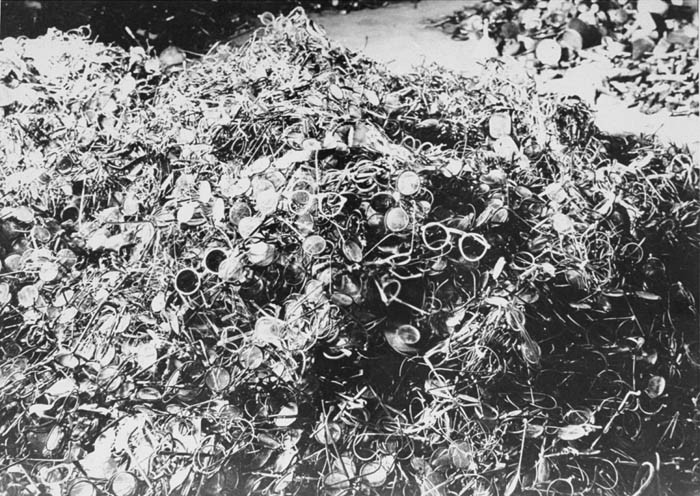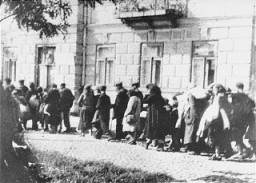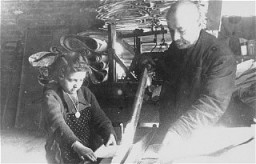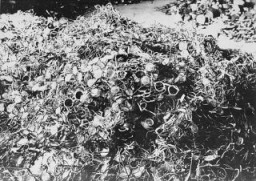
Gassing Operations
The Nazis killed millions of people in gas vans or in stationary gas chambers. The victims were people with disabilities and later Jews and other prisoners. The vast majority of those killed by gassing were Jews.
-
1
The six killing facilities in the Euthanasia Program used gas chambers, disguised as shower facilities,to kill patients with pure chemically manufactured carbon monoxide gas.
-
2
Gas vans with carbon monoxide exhaust piped into the passenger compartment were used by killing squads in the east and at the Chelmno killing center.
-
3
Gas chambers were installed at many camps. At the five killing centers, either carbon monoxide or a pesticide, Zyklon B, was used for mass murder.
The Nazis began experimenting with poison gas for the purpose of mass murder in late 1939 with the killing of patients with mental and physical disabilities in the Euthanasia Program.
Euthanasia Program
A Nazi euphemism, "euthanasia" referred to the systematic killing of those Germans whom the Nazis deemed "unworthy of life" because of mental illness or physical disability.
Six gassing installations were established as part of the Euthanasia Program: Bernburg, Brandenburg, Grafeneck, Hadamar, Hartheim, and Sonnenstein. These killing centers used pure, chemically manufactured carbon monoxide gas.
Gas Vans
After the June 1941 German invasion of the Soviet Union and Einsatzgruppe mass shootings of civilians, the Nazis experimented with gas vans for mass killing. Gas vans were hermetically sealed trucks with engine exhaust diverted to the interior compartment. Use of gas vans began after Einsatzgruppe members complained of battle fatigue and mental anguish caused by shooting large numbers of women and children. Gassing also proved to be less costly. Einsatzgruppen gassed hundreds of thousands of people, mostly Jews, Roma (Gypsies), and mentally ill people.
Killing Centers
Chelmno
In 1941, the SS concluded that the deportation of Jews to killing centers (to be gassed) was the most efficient way of achieving the "Final Solution." That same year, the Nazis opened the Chelmno camp in German-occupied Poland. Jews from the Lodz area of German-occupied Poland and Roma were killed there in mobile gas vans.
Belzec, Sobibor, and Treblinka
In 1942, systematic mass killing in stationary gas chambers began at Belzec, Sobibor, and Treblinka, all in German-occupied Poland. These gas chambers used carbon monoxide gas generated by diesel engines. As victims were "unloaded" from cattle cars, they were told that they had to be disinfected in "showers." The Nazi and Ukrainian guards sometimes shouted at and beat the victims, who were ordered to enter the "showers" with raised arms to allow as many people as possible to fit into the gas chambers. The tighter the gas chambers were packed, the faster the victims suffocated.
Auschwitz
The Nazis constantly searched for more efficient means of extermination. At the Auschwitz camp in German-occupied Poland, they conducted experiments with Zyklon B (previously used for fumigation) by gassing some 600 Soviet prisoners of war and 250 ill prisoners in September 1941. Zyklon B pellets, converted to lethal gas when exposed to air. They proved the quickest gassing method and were chosen as the means of mass murder at Auschwitz.
At the height of the deportations in 1943–44, an average of 6,000 Jews were gassed each day at Auschwitz.
Gassing Operations: Oral History Excerpts
Concentration Camps
Concentration camps like Stutthof, Mauthausen, Sachsenhausen, and Ravensbrück, although not designed specifically as killing centers, also had gas chambers. The gas chambers were relatively small, constructed to kill those prisoners the Nazis deemed "unfit" to work. Most of these camps used Zyklon B as the killing agent in their gas chambers.
Critical Thinking Questions
- How were the operations against people with disabilities similar or dissimilar to the gassing of the Jews in the Final Solution?
- Why did the mass killing operations switch to more centralized and stationary operations?
Further Reading
Kogon, Eugen, Hermann Langbein, and Adalbert Rückerl, editors. Nazi Mass Murder: A Documentary History of the Use of Poison Gas. New Haven: Yale University Press, 1994.
Müller, Filip, and Helmut Freitag. Eyewitness Auschwitz: Three Years in the Gas Chambers. Chicago: Ivan R. Dee, 1999.
Pressac, Jean-Claude. Auschwitz: Technique and Operation of the Gas Chambers. New York: Beate Klarsfeld Foundation, 1989.
Swiebocka, Teresa, editor. The Architecture of Crime: The "Central Camp Sauna" in Auschwitz II-Birkenau. Oswiecim: Auschwitz-Birkenau State Museum, 2001.








